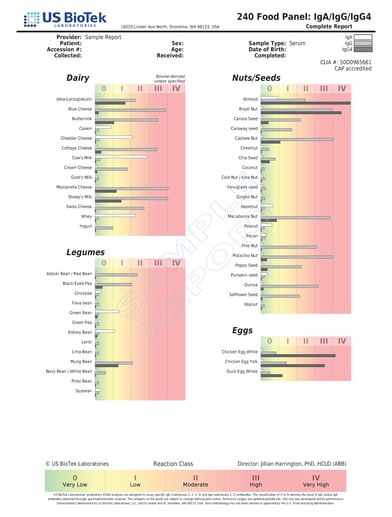4 Questions On NAD/NADH Testing Answered
Unlocking the Secrets of Cellular Energy

For health providers, one of the primary goals is to help patients achieve optimal health through methods that address the root cause of symptoms. Often, addressing food sensitivities is part of this process. However, identifying food sensitivities can be tricky, as symptoms can be vague and widespread. Inaccurate testing can lead to unnecessary dietary restrictions, while missing a true food sensitivity can result in ongoing health issues. This article will explore four common mistakes when evaluating food sensitivities and how to avoid them best.
The original approach to identifying food sensitivities was using an elimination diet. These diets can be effective if patients are diligent, but they are time-consuming and can overly restrict patients' diets unnecessarily. Diet restrictions can limit the foods patients are comfortable eating, leading to more considerable unintended consequences such as nutrient deficiencies or impaired gut health.
The biggest problem with elimination diets is their accuracy. Relying on patients to properly monitor and document their food intake and symptoms leaves large margins for error. These error potentials are exacerbated if a patient eliminates various foods at once. The combined result may provide inaccurate results. Elevations IgG1-3 cause different symptoms and may require different treatment than elevations in IgG4.
An accurate food sensitivity test can provide guidance on which specific foods to eliminate, speeding up the identification process and reducing the need to eliminate unnecessary foods. Testing the correct or multiple antibodies to foods can provide a more accurate and fuller picture of how various foods impact your patient's well-being.
Food sensitivity tests can reliably determine which foods may be the triggers for unwanted symptoms or health issues. The vast majority of food sensitivity tests only test for total Immunoglobulin G, which incorporates IgG 1-4. The combined results of IgG 1-4 may provide inaccurate results and impair proper treatment strategies due to the fact that evaluations of IgG1-3 cause symptoms that may require different treatment than the evaluations on IgG4.
To avoid this mistake, ensure your food sensitivity test is testing for IgG1-3 and IgG4 separately. IgG4 is a blocking antibody that tends to rise in accordance with IgE allergies. High IgG4 levels may provide false positives on foods your patients are not actually sensitive to. Testing IgG4 separately also provides additional information, as elevated levels not associated with IgE reactivity can indicate autoimmune conditions such as eosinophilic esophagitis.
It is also important to have IgA testing available for your food sensitivity tests as it provides additional information into the proinflammatory reactions of the complement system. Serum IgA levels are associated with allergies and asthma, and a serum IgA reaction to food triggers can indicate foods irritating the lining of the gut or other mucosal membranes.
For a more in-depth information on Food Sensitivity Antibodies, you can download the Antibody eBook How to Choose The Right Antibody For Your Food Sensitivity Test here >>
Unfortunately, not all food sensitivity tests are created equal. There are different testing methods that produce results with varying degrees of accuracy and reproducibility. To make sure you are getting the most reliable results possible for your patients there are two main things to consider.
The first way to ensure test accuracy and reliability is to utilize a food sensitivity test with a tried-and-true testing methodology. The gold standard for this is the ELISA (enzyme-linked immunosorbent assay) analysis of the specific immunoglobin(s) IgG, IgA, and IgG4, as it has been a used testing methodology in food sensitivity tests for nearly 30 years and has thousands of third-party studies validating its effectiveness.
One such study in the Natural Medicine Journal (Hodson, 2014) independently assessed different test methods for reproducibility and reliability. The study found that split samples sent to 2 different labs, one performing the cell size method and one performing the ELISA Method.
The cell size method only produced identical results on 17 out of 50 (34%) foods tested while the ELISA method produced identical results on 91 out of 96 (95%) foods tested.
Another way to ensure accuracy and reproducibility for your patience is to use a laboratory that implements standard duplicate testing. Duplicate testing will ensure precision and reproducibility by testing and validating the reproducibility of the sample in real-time.
At US BioTek, we utilize the ELISA testing methodology as part of our VeriTek process, which includes duplicate testing, to ensure our food sensitivity panels produce the most accurate and reproducible results.
Click here to learn more about our VeriTek process >>
 It may seem obvious, but often when testing for food sensitivities, we can miss foods that patients eat consistently if they eat a diet other than the standard North American Diet. For example, if a patient is a vegetarian, there is no need to test their reactivity to beef and chicken, but they should be tested for artichokes, jackfruit, basil, and dates. The same goes for individuals who subscribe to various cultural diets. If someone is eating a diet based on a more East Asian diet, they be tested for foods like persimmon, squid, and black tea which are not standard on every food sensitivity test.
It may seem obvious, but often when testing for food sensitivities, we can miss foods that patients eat consistently if they eat a diet other than the standard North American Diet. For example, if a patient is a vegetarian, there is no need to test their reactivity to beef and chicken, but they should be tested for artichokes, jackfruit, basil, and dates. The same goes for individuals who subscribe to various cultural diets. If someone is eating a diet based on a more East Asian diet, they be tested for foods like persimmon, squid, and black tea which are not standard on every food sensitivity test.
At US BioTek, we test for up to 240 markers to ensure our food sensitivity tests have the foods, herbs, and spices common in most diets. There are also various 96 food panels built to offer individuals who subscribe to a variety of diets a more cost-effective option. You can learn more about these specialized diet panels here https://www.usbiotek.com/food-sensitivity-testing.
Conclusion:
Evaluating food sensitivities is a critical aspect of a complete health evaluation and can be a great tool to improve a patient's overall health and well-being quickly. By avoiding the four mistakes outlined above, you can improve the clinical success of your food sensitivity testing and get patients the symptom relief and health outcomes they need more efficiently.
The evaluation of food sensitivity is a critical aspect of a complete health evaluation and can be a great tool to improve a patient's overall health and well-being quickly. Avoid these four mistakes and improve the clinical success of your practice.
To learn more about US BioTek’s reliable and reproducible ELISA Food Sensitivity Testing, visit: https://www.usbiotek.com/food-sensitivity-testing
Resources:
Hodson W. (2014) NMJ Original Research: Reproducibility and Reliability of Two Food Allergy Testing Methods. Natural Med J. https://www.naturalmedicinejournal.com/journal/nmj-original-research-reproducibility-and-reliability-two-food-allergy-testing Accessed 06 September 2023
Serum IgE and IgG responses to food antigens in normal and atopic dogs, and dogs with gastrointestinal disease https://pubmed.ncbi.nlm.nih.gov/12730012/
The Role of Complement in Inflammatory Diseases From Behind the Scenes into the Spotlight https://www.ncbi.nlm.nih.gov/pmc/articles/PMC1959484/
Diet restriction in migraine, based on IgG against foods: A clinical double-blind, randomized, cross-over trial https://www.ncbi.nlm.nih.gov/pmc/articles/PMC2899772/
Food-specific IgGs Are Highly Increased in the Sera of Patients with Inflammatory Bowel Disease and Are Clinically Relevant to the Pathogenesis https://www.jstage.jst.go.jp/article/internalmedicine/57/19/57_9377-17/_article
EOSINOPHILIC GASTROENTERITIS: HOW NATUROPATHIC PHYSICIANS CAN HELP https://ndnr.com/gastrointestinal/eosinophilic-gastroenteritis-how-naturopathic-physicians-can-help/
Role of IgG 4 in IgE-mediated allergic responses https://pubmed.ncbi.nlm.nih.gov/27566454/
The inflammatory function of human IgA https://www.ncbi.nlm.nih.gov/pmc/articles/PMC6513800/
Dysfunctions of the IgA system: a common link between intestinal and renal diseases https://www.ncbi.nlm.nih.gov/pmc/articles/PMC4003139/

Unlocking the Secrets of Cellular Energy

Short chain fatty acids (SCFAs) are organic acids produced by bacterial fermentation of dietary fibre and resistant starch. Enterocytes and...

Zonulin has emerged as a popular marker to assess the integrity of the intestinal mucosal barrier. Discovered by Dr Alessio Fasano, Zonulin...